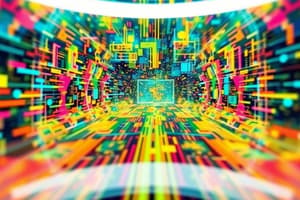Podcast
Questions and Answers
What is the main purpose of AR technology?
What is the main purpose of AR technology?
- To process data through cameras
- To generate 3D images and videos
- To create a fully immersive experience
- To enhance the user's physical environment in real-time (correct)
What is the primary function of AR's cameras?
What is the primary function of AR's cameras?
- To collect and process data to send the right content to the user (correct)
- To track the user's physical environment
- To reconstruct the scale and distances between static 2D images
- To generate 3D images and videos
What is the main difference between AR and VR?
What is the main difference between AR and VR?
- AR enhances the physical environment, while VR creates a fully immersive experience (correct)
- AR uses computer vision, while VR uses advanced graphics
- AR is used for printing, while VR is used for advertising
- AR is used for gaming, while VR is used for education
What is one of the applications of AR technology?
What is one of the applications of AR technology?
What is the primary goal of VR technology?
What is the primary goal of VR technology?
What is used to generate 3D images and video in VR systems?
What is used to generate 3D images and video in VR systems?
What is the result of AR technology in the user's physical environment?
What is the result of AR technology in the user's physical environment?
What is a common application of AR technology?
What is a common application of AR technology?
What does VR use to create a three-dimensional world?
What does VR use to create a three-dimensional world?
What does the user see when using VR?
What does the user see when using VR?
How does the user interact with the 3D content in VR?
How does the user interact with the 3D content in VR?
What is one of the main applications of VR?
What is one of the main applications of VR?
What is the main difference between AR and VR?
What is the main difference between AR and VR?
What percentage of virtual reality does AR typically have?
What percentage of virtual reality does AR typically have?
What does VR replace?
What does VR replace?
What is the main advantage of AR over VR?
What is the main advantage of AR over VR?
What devices does AR use?
What devices does AR use?
What is the primary function of controllers in VR?
What is the primary function of controllers in VR?
What is the primary role of sensors on VR headsets and controllers?
What is the primary role of sensors on VR headsets and controllers?
In which of the following industries has VR found its way into mainstream use?
In which of the following industries has VR found its way into mainstream use?
What is the key feature that differentiates AR from VR?
What is the key feature that differentiates AR from VR?
What is the primary device used to display VR content?
What is the primary device used to display VR content?
What is the main advantage of AR over VR?
What is the main advantage of AR over VR?
What is the primary purpose of overlaying digital content onto the physical environment in AR?
What is the primary purpose of overlaying digital content onto the physical environment in AR?
What is a key difference between AR and VR in terms of user experience?
What is a key difference between AR and VR in terms of user experience?
What is a common way to experience AR?
What is a common way to experience AR?
What is a key technology used in VR systems to generate 3D images and video?
What is a key technology used in VR systems to generate 3D images and video?
What is a potential application of AR in the field of interpretation?
What is a potential application of AR in the field of interpretation?
Flashcards are hidden until you start studying
Study Notes
Augmented Reality (AR)
- AR is a technology that blends the digital world with the physical environment, overlaying digital information onto the real world.
- AR uses computer vision, mapping, and depth tracking to generate content for the user.
- AR cameras collect and process data to send the right content to the user, enhancing the physical environment in real-time.
- AR can be experienced with smartphones or special hardware.
- Applications of AR include:
- Texting, embedding imagery and videos
- Printing, advertising, and digital content
- Interpretation apps and 3D tools for 3D real-time games
Virtual Reality (VR)
- VR is a fully immersive experience that allows users to undergo a real-world-feeling.
- VR attempts to regenerate computer images and videos to produce real-life visual experiences.
- VR systems use computer vision and advanced graphics to generate 3D images and video by adding depth and reconstructing scale and distances between static 2D images.
- VR headsets and controllers with sensors enable users to explore and control 3D environments.
- Applications of VR include:
- Enhancement of fictional realities in gaming
- Flight and battlefield simulation for military training
- Training device for PTSD and sports training
- Fear therapy through fictional or real-life scenes and scenarios
- Medical training for graduating students and learning new skills in a safe environment
AR vs VR
- VR creates an immersive virtual environment, while AR augments a real-world scene.
- VR is 75% virtual, while AR is only 25% virtual.
- VR requires a headset device, while AR does not.
- VR users move in a completely fictional world, while AR users are in contact with the real world.
- VR replaces the real world with the artificial, while AR enhances real life with artificial images.
- VR is suitable for games and social networking, while AR is suitable for real-world applications.
Augmented Reality (AR)
- AR is a technology that blends the digital world with the physical environment, overlaying digital information onto the real world.
- AR uses computer vision, mapping, and depth tracking to generate content for the user.
- AR cameras collect and process data to send the right content to the user, enhancing the physical environment in real-time.
- AR can be experienced with smartphones or special hardware.
- Applications of AR include:
- Texting, embedding imagery and videos
- Printing, advertising, and digital content
- Interpretation apps and 3D tools for 3D real-time games
Virtual Reality (VR)
- VR is a fully immersive experience that allows users to undergo a real-world-feeling.
- VR attempts to regenerate computer images and videos to produce real-life visual experiences.
- VR systems use computer vision and advanced graphics to generate 3D images and video by adding depth and reconstructing scale and distances between static 2D images.
- VR headsets and controllers with sensors enable users to explore and control 3D environments.
- Applications of VR include:
- Enhancement of fictional realities in gaming
- Flight and battlefield simulation for military training
- Training device for PTSD and sports training
- Fear therapy through fictional or real-life scenes and scenarios
- Medical training for graduating students and learning new skills in a safe environment
AR vs VR
- VR creates an immersive virtual environment, while AR augments a real-world scene.
- VR is 75% virtual, while AR is only 25% virtual.
- VR requires a headset device, while AR does not.
- VR users move in a completely fictional world, while AR users are in contact with the real world.
- VR replaces the real world with the artificial, while AR enhances real life with artificial images.
- VR is suitable for games and social networking, while AR is suitable for real-world applications.
Studying That Suits You
Use AI to generate personalized quizzes and flashcards to suit your learning preferences.




